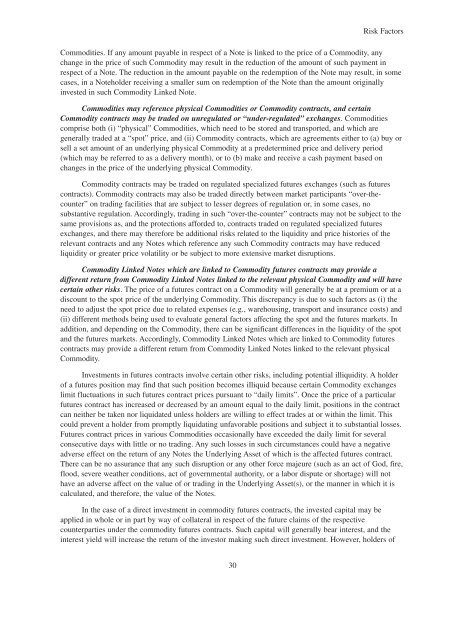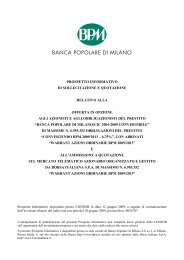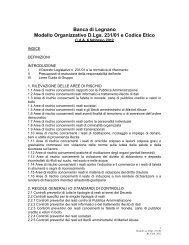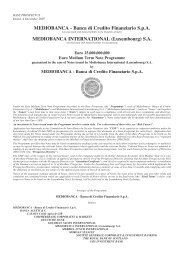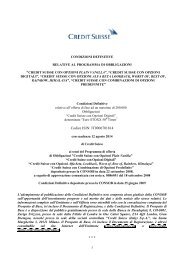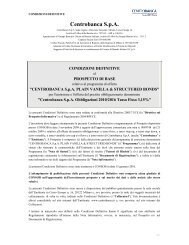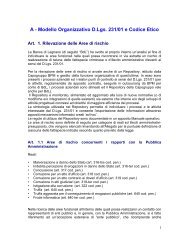INDEX OF DEFINED TERMS - Banca di Legnano
INDEX OF DEFINED TERMS - Banca di Legnano
INDEX OF DEFINED TERMS - Banca di Legnano
You also want an ePaper? Increase the reach of your titles
YUMPU automatically turns print PDFs into web optimized ePapers that Google loves.
Level: 2 – From: 2 – Wednesday, July 21, 2010 – 11:55 – eprint6 – 4247 Section 02<br />
Risk Factors<br />
Commo<strong>di</strong>ties. If any amount payable in respect of a Note is linked to the price of a Commo<strong>di</strong>ty, any<br />
change in the price of such Commo<strong>di</strong>ty may result in the reduction of the amount of such payment in<br />
respect of a Note. The reduction in the amount payable on the redemption of the Note may result, in some<br />
cases, in a Noteholder receiving a smaller sum on redemption of the Note than the amount originally<br />
invested in such Commo<strong>di</strong>ty Linked Note.<br />
Commo<strong>di</strong>ties may reference physical Commo<strong>di</strong>ties or Commo<strong>di</strong>ty contracts, and certain<br />
Commo<strong>di</strong>ty contracts may be traded on unregulated or “under-regulated” exchanges. Commo<strong>di</strong>ties<br />
comprise both (i) “physical” Commo<strong>di</strong>ties, which need to be stored and transported, and which are<br />
generally traded at a “spot” price, and (ii) Commo<strong>di</strong>ty contracts, which are agreements either to (a) buy or<br />
sell a set amount of an underlying physical Commo<strong>di</strong>ty at a predetermined price and delivery period<br />
(which may be referred to as a delivery month), or to (b) make and receive a cash payment based on<br />
changes in the price of the underlying physical Commo<strong>di</strong>ty.<br />
Commo<strong>di</strong>ty contracts may be traded on regulated specialized futures exchanges (such as futures<br />
contracts). Commo<strong>di</strong>ty contracts may also be traded <strong>di</strong>rectly between market participants “over-thecounter”<br />
on tra<strong>di</strong>ng facilities that are subject to lesser degrees of regulation or, in some cases, no<br />
substantive regulation. Accor<strong>di</strong>ngly, tra<strong>di</strong>ng in such “over-the-counter” contracts may not be subject to the<br />
same provisions as, and the protections afforded to, contracts traded on regulated specialized futures<br />
exchanges, and there may therefore be ad<strong>di</strong>tional risks related to the liqui<strong>di</strong>ty and price histories of the<br />
relevant contracts and any Notes which reference any such Commo<strong>di</strong>ty contracts may have reduced<br />
liqui<strong>di</strong>ty or greater price volatility or be subject to more extensive market <strong>di</strong>sruptions.<br />
Commo<strong>di</strong>ty Linked Notes which are linked to Commo<strong>di</strong>ty futures contracts may provide a<br />
<strong>di</strong>fferent return from Commo<strong>di</strong>ty Linked Notes linked to the relevant physical Commo<strong>di</strong>ty and will have<br />
certain other risks. The price of a futures contract on a Commo<strong>di</strong>ty will generally be at a premium or at a<br />
<strong>di</strong>scount to the spot price of the underlying Commo<strong>di</strong>ty. This <strong>di</strong>screpancy is due to such factors as (i) the<br />
need to adjust the spot price due to related expenses (e.g., warehousing, transport and insurance costs) and<br />
(ii) <strong>di</strong>fferent methods being used to evaluate general factors affecting the spot and the futures markets. In<br />
ad<strong>di</strong>tion, and depen<strong>di</strong>ng on the Commo<strong>di</strong>ty, there can be significant <strong>di</strong>fferences in the liqui<strong>di</strong>ty of the spot<br />
and the futures markets. Accor<strong>di</strong>ngly, Commo<strong>di</strong>ty Linked Notes which are linked to Commo<strong>di</strong>ty futures<br />
contracts may provide a <strong>di</strong>fferent return from Commo<strong>di</strong>ty Linked Notes linked to the relevant physical<br />
Commo<strong>di</strong>ty.<br />
Investments in futures contracts involve certain other risks, inclu<strong>di</strong>ng potential illiqui<strong>di</strong>ty. A holder<br />
of a futures position may find that such position becomes illiquid because certain Commo<strong>di</strong>ty exchanges<br />
limit fluctuations in such futures contract prices pursuant to “daily limits”. Once the price of a particular<br />
futures contract has increased or decreased by an amount equal to the daily limit, positions in the contract<br />
can neither be taken nor liquidated unless holders are willing to effect trades at or within the limit. This<br />
could prevent a holder from promptly liquidating unfavorable positions and subject it to substantial losses.<br />
Futures contract prices in various Commo<strong>di</strong>ties occasionally have exceeded the daily limit for several<br />
consecutive days with little or no tra<strong>di</strong>ng. Any such losses in such circumstances could have a negative<br />
adverse effect on the return of any Notes the Underlying Asset of which is the affected futures contract.<br />
There can be no assurance that any such <strong>di</strong>sruption or any other force majeure (such as an act of God, fire,<br />
flood, severe weather con<strong>di</strong>tions, act of governmental authority, or a labor <strong>di</strong>spute or shortage) will not<br />
have an adverse affect on the value of or tra<strong>di</strong>ng in the Underlying Asset(s), or the manner in which it is<br />
calculated, and therefore, the value of the Notes.<br />
In the case of a <strong>di</strong>rect investment in commo<strong>di</strong>ty futures contracts, the invested capital may be<br />
applied in whole or in part by way of collateral in respect of the future claims of the respective<br />
counterparties under the commo<strong>di</strong>ty futures contracts. Such capital will generally bear interest, and the<br />
interest yield will increase the return of the investor making such <strong>di</strong>rect investment. However, holders of<br />
30


